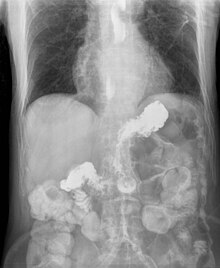User:Mr. Ibrahem/Gastroesophageal reflux disease
| Gastroesophageal reflux disease | |
|---|---|
| Other names | British: Gastro-oesophageal reflux disease (GORD);[1] gastric reflux disease, acid reflux disease, reflux, gastroesophageal reflux |
 | |
| X-ray showing radiocontrast from the stomach (white material below diaphragm) entering the esophagus (three vertical collections of white material in the mid-line of the chest) due to severe reflux | |
| Pronunciation | |
| Specialty | Gastroenterology |
| Symptoms | Taste of acid, heartburn, bad breath, chest pain, breathing problems[5] |
| Complications | Esophagitis, esophageal strictures, Barrett's esophagus[5] |
| Duration | Long term[5][6] |
| Causes | Inadequate closure of the lower esophageal sphincter[5] |
| Risk factors | Obesity, pregnancy, smoking, hiatal hernia, taking certain medicines[5] |
| Diagnostic method | Gastroscopy, upper GI series, esophageal pH monitoring, esophageal manometry[5] |
| Differential diagnosis | Peptic ulcer disease, esophageal cancer, esophageal spasm, angina[7] |
| Treatment | Lifestyle changes, medications, surgery[5] |
| Medication | Antacids, H2 receptor blockers, proton pump inhibitors, prokinetics[5][8] |
| Frequency | ~15% (Western populations)[8] |
Gastroesophageal reflux disease (GERD), also known as acid reflux, is a long-term condition in which stomach contents rise up into the esophagus, resulting in either symptoms or complications.[5][6] Symptoms include the taste of acid in the back of the mouth, heartburn, bad breath, chest pain, regurgitation, breathing problems, and wearing away of the teeth.[5] Complications include esophagitis, esophageal stricture, and Barrett's esophagus.[5]
Risk factors include obesity, pregnancy, smoking, hiatal hernia, and taking certain medicines.[5] Medications involved may include antihistamines, calcium channel blockers, antidepressants and sleeping pills.[5] Acid reflux is due to poor closure of the lower esophageal sphincter, which is at the junction between the stomach and the esophagus.[5] Diagnosis among those who do not improve with simpler measures may involve gastroscopy, upper GI series, esophageal pH monitoring, or esophageal manometry.[5]
Treatment options include lifestyle changes; medications; and sometimes surgery for those who do not improve with the first two measures.[5] Lifestyle changes include not lying down for three hours after eating, raising the head of the bed, losing weight, avoiding foods which result in symptoms, and stopping smoking.[5] Medications include antacids, H2 receptor blockers, proton pump inhibitors, and prokinetics.[5][8]
In the Western world, between 10 and 20% of the population is affected by GERD.[8] Occasional gastroesophageal reflux without troublesome symptoms or complications is even more common.[5] The classic symptoms of GERD were first described in 1925, when Friedenwald and Feldman commented on heartburn and its possible relationship to a hiatal hernia.[9] In 1934 gastroenterologist Asher Winkelstein described reflux and attributed the symptoms to stomach acid.[10]
References[edit]
- ^ Carroll, Will (14 October 2016). Gastroenterology & Nutrition: Prepare for the MRCPCH. Key Articles from the Paediatrics & Child Health journal. Elsevier Health Sciences. p. 130. ISBN 9780702070921.
Gastro-oesophageal reflux disease (GORD) is defined as 'gastrooesophageal reflux' associated with complications including oesophagitis...
- ^ "Definition of "gastro-" - Collins American English Dictionary". Archived from the original on 8 December 2015.
- ^ "Definition of "esophagus" - Collins American English Dictionary". Archived from the original on 8 December 2015.
- ^ "reflux noun - Definition, pictures, pronunciation and usage notes - Oxford Advanced American Dictionary at OxfordLearnersDictionaries.com". Archived from the original on 8 December 2015.
- ^ a b c d e f g h i j k l m n o p q r s "Acid Reflux (GER & GERD) in Adults". National Institute of Diabetes and Digestive and Kidney Diseases (NIDDK). 5 November 2015. Archived from the original on 22 February 2020. Retrieved 21 February 2020.
- ^ a b Kahrilas PJ, Shaheen NJ, Vaezi MF (October 2008). "American Gastroenterological Association Institute technical review on the management of gastroesophageal reflux disease". Gastroenterology. 135 (4): 1392–1413, 1413.e1–5. doi:10.1053/j.gastro.2008.08.044. PMID 18801365.
- ^ Kahan, Scott (2008). In a Page: Medicine. Lippincott Williams & Wilkins. p. 124. ISBN 9780781770354. Archived from the original on 8 September 2017.
- ^ a b c d Hershcovici T, Fass R (April 2011). "Pharmacological management of GERD: where does it stand now?". Trends in Pharmacological Sciences. 32 (4): 258–64. doi:10.1016/j.tips.2011.02.007. PMID 21429600.
- ^ Granderath, Frank Alexander; Kamolz, Thomas; Pointner, Rudolph (2006). Gastroesophageal Reflux Disease: Principles of Disease, Diagnosis, and Treatment. Springer Science & Business Media. p. 161. ISBN 9783211323175. Archived from the original on 1 January 2020. Retrieved 22 June 2020.
- ^ Arcangelo, Virginia Poole; Peterson, Andrew M. (2006). Pharmacotherapeutics for Advanced Practice: A Practical Approach. Lippincott Williams & Wilkins. p. 372. ISBN 9780781757843. Archived from the original on 5 January 2020. Retrieved 22 June 2020.
